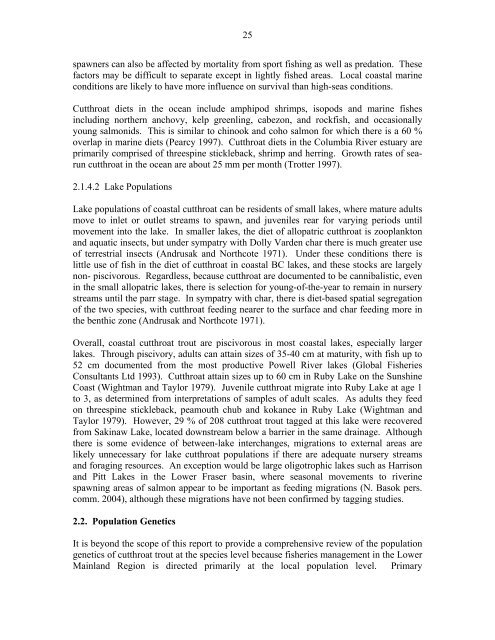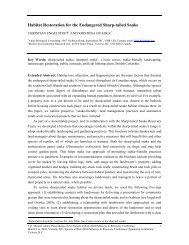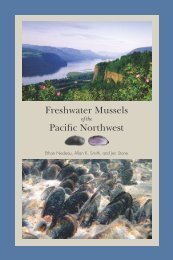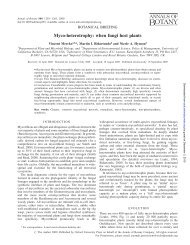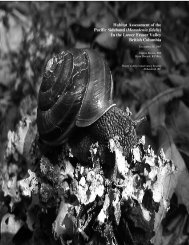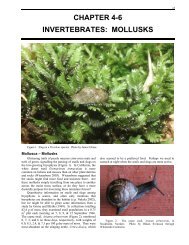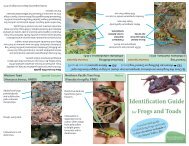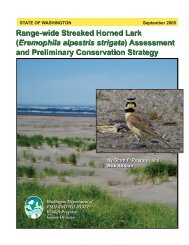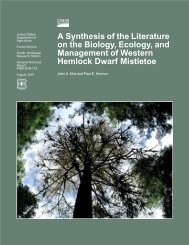Coastal Cutthroat Trout as Sentinels of Lower Mainland Watershed ...
Coastal Cutthroat Trout as Sentinels of Lower Mainland Watershed ...
Coastal Cutthroat Trout as Sentinels of Lower Mainland Watershed ...
You also want an ePaper? Increase the reach of your titles
YUMPU automatically turns print PDFs into web optimized ePapers that Google loves.
25spawners can also be affected by mortality from sport fishing <strong>as</strong> well <strong>as</strong> predation. Thesefactors may be difficult to separate except in lightly fished are<strong>as</strong>. Local co<strong>as</strong>tal marineconditions are likely to have more influence on survival than high-se<strong>as</strong> conditions.<strong>Cutthroat</strong> diets in the ocean include amphipod shrimps, isopods and marine fishesincluding northern anchovy, kelp greenling, cabezon, and rockfish, and occ<strong>as</strong>ionallyyoung salmonids. This is similar to chinook and coho salmon for which there is a 60 %overlap in marine diets (Pearcy 1997). <strong>Cutthroat</strong> diets in the Columbia River estuary areprimarily comprised <strong>of</strong> threespine stickleback, shrimp and herring. Growth rates <strong>of</strong> searuncutthroat in the ocean are about 25 mm per month (Trotter 1997).2.1.4.2 Lake PopulationsLake populations <strong>of</strong> co<strong>as</strong>tal cutthroat can be residents <strong>of</strong> small lakes, where mature adultsmove to inlet or outlet streams to spawn, and juveniles rear for varying periods untilmovement into the lake. In smaller lakes, the diet <strong>of</strong> allopatric cutthroat is zooplanktonand aquatic insects, but under sympatry with Dolly Varden char there is much greater use<strong>of</strong> terrestrial insects (Andrusak and Northcote 1971). Under these conditions there islittle use <strong>of</strong> fish in the diet <strong>of</strong> cutthroat in co<strong>as</strong>tal BC lakes, and these stocks are largelynon- piscivorous. Regardless, because cutthroat are documented to be cannibalistic, evenin the small allopatric lakes, there is selection for young-<strong>of</strong>-the-year to remain in nurserystreams until the parr stage. In sympatry with char, there is diet-b<strong>as</strong>ed spatial segregation<strong>of</strong> the two species, with cutthroat feeding nearer to the surface and char feeding more inthe benthic zone (Andrusak and Northcote 1971).Overall, co<strong>as</strong>tal cutthroat trout are piscivorous in most co<strong>as</strong>tal lakes, especially largerlakes. Through piscivory, adults can attain sizes <strong>of</strong> 35-40 cm at maturity, with fish up to52 cm documented from the most productive Powell River lakes (Global FisheriesConsultants Ltd 1993). <strong>Cutthroat</strong> attain sizes up to 60 cm in Ruby Lake on the SunshineCo<strong>as</strong>t (Wightman and Taylor 1979). Juvenile cutthroat migrate into Ruby Lake at age 1to 3, <strong>as</strong> determined from interpretations <strong>of</strong> samples <strong>of</strong> adult scales. As adults they feedon threespine stickleback, peamouth chub and kokanee in Ruby Lake (Wightman andTaylor 1979). However, 29 % <strong>of</strong> 208 cutthroat trout tagged at this lake were recoveredfrom Sakinaw Lake, located downstream below a barrier in the same drainage. Althoughthere is some evidence <strong>of</strong> between-lake interchanges, migrations to external are<strong>as</strong> arelikely unnecessary for lake cutthroat populations if there are adequate nursery streamsand foraging resources. An exception would be large oligotrophic lakes such <strong>as</strong> Harrisonand Pitt Lakes in the <strong>Lower</strong> Fr<strong>as</strong>er b<strong>as</strong>in, where se<strong>as</strong>onal movements to riverinespawning are<strong>as</strong> <strong>of</strong> salmon appear to be important <strong>as</strong> feeding migrations (N. B<strong>as</strong>ok pers.comm. 2004), although these migrations have not been confirmed by tagging studies.2.2. Population GeneticsIt is beyond the scope <strong>of</strong> this report to provide a comprehensive review <strong>of</strong> the populationgenetics <strong>of</strong> cutthroat trout at the species level because fisheries management in the <strong>Lower</strong><strong>Mainland</strong> Region is directed primarily at the local population level. Primary


